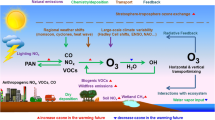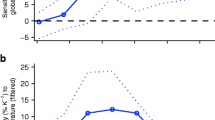Abstract
The mesoscale orographic effects on typhoon Aere’s precipitation are simulated using an Advanced Regional Eta-coordinate Model (AREM) version 3.0. In particular, the effects of the latent heat release are studied by two comparable experiments: with and without condensational heating. The results show that the typhoon rainfall is tripled by the southeastern China mesoscale terrain, and the condensational heating is responsible for at least half of the increase. One role of the latent heat release is to warm the atmosphere, leading to a depression of the surface pressure, which then causes a larger pressure difference in the zonal direction. This pressure gradient guides the water vapour to flow into the foothills, which in turn amplifies the water vapour flux divergence amplified, causing the typhoon rainfall to increase eventually. The other role of the latent heat release is to make the convection more organized, resulting in a relatively smaller rain area and stronger precipitation.
Similar content being viewed by others
References
Benjamin, S. O., and N. L. Seaman, 1985: A simple scheme for objective analysis in curved flow. Mon. Wea. Rev., 113, 1184–1198.
Betts, A. K., 1986: A new convective adjustment scheme, Part I: Observational and theoretical basis. Quart. J. Roy. Meteor. Soc., 112, 677–691.
Brennan, M. J., and G. M. Lackmann, 2005: The influence of incipient latent heat release on the precipitation distribution of the 24–25 January 2000 U.S. east coast cyclone. Mon. Wea. Rev., 133, 1913–1937.
Buzzi, A., N. Tartaglione, and P. Malguzzi, 1998: Numerical simulations of the 1994 Piedmont flood: Role of topography and moist processes. Mon. Wea. Rev., 126, 2369–2383.
Carbone, R. E., W. A. Cooper, and W. C. Lee, 1995: On the forcing of flow reversal along the windward slopes of Hawaii. Mon. Wea. Rev., 123, 34–56.
Deardorff, J. W., 1972: Parameterization of the planetary boundary layer for use in general circulation models. Mon. Wea. Rev., 100, 93–106.
Feng Qiang, Ye Rujie, Wang Angsheng, Tao Shiyan, Xu Huanbin, and Gao Shouting, 2004: The study on effects of meso-scale terrain on precipitation of torrential rain by numerical modeling. Chinese Journal of Agrometeorology, 25, 1–4. (in Chinese)
Fosdick, E. K. and P. J. Smith, 1991: Latent heat release in an extratropical cyclone that developed explosively over the southeastern United States. Mon. Wea. Rev., 119, 193–207.
Gao Kun, Zhai Guoqing, Yu Zhangxiao and Tu Caihong, 1994: The simulation study of the meso-scale orographic effects on heavy rain in East China. Acta Meteorologica Sinica, 52, 157–164. (in Chinese)
Holtslag, A. A. M., and B. A. Boville, 1993: Local versus nonlocal boundary-layer diffusion in a global climate model. J. Climate, 6, 1825–1842.
Kodama, K. R, and G. M. Barnes, 1997: Heavy rain events over the south-facing slopes of Hawaii: Attendant conditions. Wea. Forecasting, 12, 347–336.
Liu, Y. M., G. X. Wu, H. Liu., and P. Liu, 2001: Condensation heating of the Asian summer monsoon and the subtropical anticyclone in the eastern hemisphere. Climate Dyn., 17, 327–338.
Neiman, P. J., F. M. Ralph, A. B. White, D. E. Kingsmill, and P. O. G. Persson, 2002: The statistical relationship between upslope flow and rainfall in California’s coastal mountains: Observations during CALJET. Mon. Wea. Rev., 130, 1468–1492.
Pauley, P. M., and P. J. Smith, 1988: Direct and indirect effects of latent heat release on a synoptic-scale wave system. Mon. Wea. Rev., 116, 1209–1235.
Posselt, D. J., and J. E. Martin, 2004: The effect of latent heat release on the evolution of a warm occluded thermal structure. Mon. Wea. Rev., 132, 578–599.
Smith, R. B., 1979: The influence of mountains on the atmosphere. Advances in Geophysics, 21, 87–137.
Tao Shiyan, 1980: Rain Storms in China. Science Press, Beijing, 225pp. (in Chinese)
Xu Youping, Xia Daqing, and Qian Yueying, 1998: The water-bearing numerical model and its operational forecasting experiments Part II: The operational forecasting experiments. Adv. Atmos. Sci., 15, 321–336.
Yu Rucong, 1994: Two-step shape-preserving advection scheme. Adv. Atmos. Sci., 11, 479–490.
Yu Rucong, and Xu Youping, 2004: AREM and its simulations on the daily rainfall in summer in 2003. Acta Meteorologica Sinica, 62, 715–724. (in Chinese)
Zang Zengliang, Zhang Ming, Shen Hongwei, and Yao Haohai, 2004: Experiments on the sensitivity of meso-scale terrains in JangHuai area to a heavy mold rain. Scientia Meteorologica Sinica, 24, 26–34. (in Chinese)
Zhai Guoqing, Gao Kun, Yu Zhangxiao, and Tu Caihong, 1995: Numerical simulation of the effects of meso-scale topography in a heavy rain process. Scientia Atmospherica Sinica, 19, 475–480. (in Chinese)
Zhou Tianjun, and Qian Yongfu, 1996: An experimental study on the effects of topography on numerical prediction. Scientia Atmospherica Sinica, 20, 452–462. (in Chinese)
Author information
Authors and Affiliations
Rights and permissions
About this article
Cite this article
Li, Y., Huang, W. & Zhao, J. Roles of mesoscale terrain and latent heat release in typhoon precipitation: A numerical case study. Adv. Atmos. Sci. 24, 35–43 (2007). https://doi.org/10.1007/s00376-007-0035-8
Received:
Revised:
Issue Date:
DOI: https://doi.org/10.1007/s00376-007-0035-8




